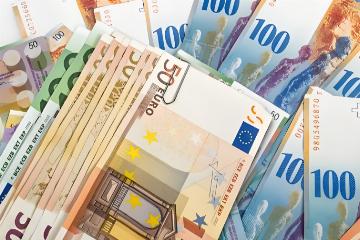Eurozone Growth Stalls
Advertisements
It is a well-known fact that every central bank president faces pivotal moments that can determine their legacy and the future of their institutionBack in 2012, during the height of the eurozone crisis, Mario Draghi, who was serving as the president of the European Central Bank (ECB) at the time, infamously characterized the euro as a "big bumblebee." The sentiment behind this metaphor was that while the currency union might appear flawed and unorthodox, it was, against all odds, managing to survive and functionHowever, this optimistic view didn’t last longJust a few months later, with economic turbulence threatening to shatter the fragile stability of the eurozone, Draghi took a decisive stance, leading the ECB into what is now referred to as the “whatever it takes” eraThis declaration was meant to reassure markets that the bank would do whatever necessary to preserve the euro.
Fast forward to today, the euro is not in a major crisis, but there seems to be a creeping complacency reminiscent of that bumblebee analogy
Advertisements
The spirit of 'whatever it takes' appears to be insufficient in reigniting investment, fostering growth, and restoring confidence within the euro areaThe growing economic divergence between the northern and southern states of the eurozone, coupled with geopolitical tensions that still simmer in the background, poses unprecedented challengesDraghi had recently proposed measures aimed at dismantling structural barriers to economic growth, but the urgency of these proposals is now perilously close to fading into obscurity.
With the economic engines of Europe’s two largest nations—the French and German economies—beginning to stall, the current ECB president, Christine Lagarde, faces a critical juncture in her tenureAs trade tensions with the United States loom, it becomes imperative for leadership within France and Germany to galvanize significant action through institutions like the ECB, much like her predecessor did over a decade ago
Advertisements
Since June, the ECB has cut interest rates four times, which signals an acknowledgment of the immediate economic pressuresHowever, Lagarde and the bank’s communications remain cautious, almost stuck in a vault of conservative rhetoric.
The pressing need today is to shift the focus from merely containing inflation to actively stimulating growthSince 2019, the eurozone’s GDP has only grown by 2.5%, while the United States surged ahead with a growth of 7.9%. Expectations for the eurozone's GDP growth this year predict rates plummeting below 1%, which is alarmingWhile ECB leaders often assert that monetary policy cannot solve all problems—an undeniable truth—they must recognize the significant investment necessities looming over the next decade in sectors like technology, defense, and climate changeSuch demands require a bold and proactive approach, rather than lingering in a conservative comfort zone.
However, the act of significantly lowering interest rates to stimulate economic activity is a nuanced endeavor
Advertisements
A rapid or excessive reduction could spark inflation, which would in turn diminish the euro’s value against the dollar, leading to a loss of confidence in the currencyThe current pressing danger lies in the insufficient rate cuts from the ECB amidst growing pressure on governments to reduce deficits and manage debt, all of which ultimately threaten to suppress demand even furtherIn an increasingly protectionist global environment, fostering domestic consumption and encouraging investment must become top prioritiesThis can only be achieved through synchronized efforts between monetary policy and fiscal strategies.
Additionally, recent trends indicate a swift decline in eurozone inflation rates, which do little to mask the underlying cracks in economic strategy and stabilityIt is no longer adequate to uphold the narrative that the ECB’s primary responsibility is price stability
- Stocks on Brink? Fed Rate Hike Debate Heats Up
- Transaction Banks Tap Platform Strategy for Growth
- Strong Demand for Global Electric Vehicle Market
- Treasury Yields Hit New Low Amid Wealth Shift
- Crossroads of Wealth: Where Do You Stand?
The institution has a dual mandate that also encompasses financial stability, an area deeply jeopardized by recessionary pressures which threaten smooth monetary transmissionEncouragingly, François Villeroy de Galhau, the governor of the Bank of France, has recently aligned himself with this sentiment by carefully echoing the caution expressed by his German counterpart, Joachim Nagel.
Villeroy de Galhau explicitly stated that while price stability remains the ECB’s foremost goal, the institution must also “keep a close watch” on the risks associated with inflation dipping below its target and economic activity suffering undue sluggishnessFurthermore, he underscored the necessity for central banks to address issues that extend beyond monetary policyHe posed a crucial question: “If we do not defend open trade and fair rules, who will?”
This delicate balance of maintaining a prudent economic strategy could lead to public discontent shifting towards the central bank president herself, rather than resulting solely in the downfall of current populist politicians

There are whispers among European business leaders who discreetly express misgivings about the ECB’s handling of monetary policy, suggesting that much of Europe’s recession compared to the United States can be attributed to the ECB’s excessive bureaucratic regulations on the banking industry and its stringent monetary policiesThis should raise alarms in Frankfurt; how long before international investors and CEOs start publicly questioning the future of the euro?
Overall, the current economic landscape sends one clear message: it is a crucial moment for Christine Lagarde and the ECB to step into a more active leadership roleStaging a united front between monetary and fiscal policies can help usher in a more prosperous era for the continent’s economyWhile risks will invariably accompany this course of action, the potential rewards could invigorate Europe’s economy with renewed energy and dynamism if navigated effectively.